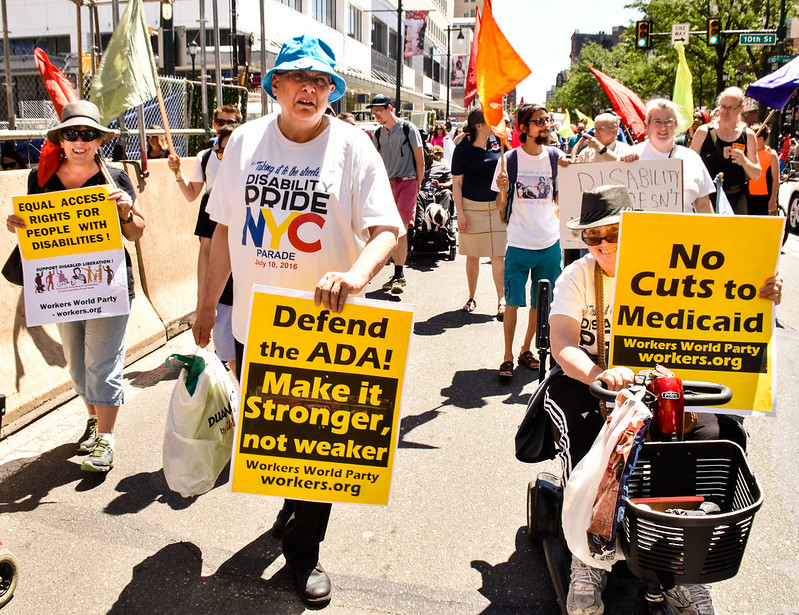The subminimum wage allows employers to pay people with disabilities cents on the hour for their work. A provision in the Build Back Better Act would incentivize states to help end the practice.

This story originally appeared on The 19th.
For almost a century, it has been completely legal for companies to pay workers with disabilities mere cents on the hour. Employees have reported receiving pennies in their paychecks, with no limit on how little they can be paid.
This practice of paying “subminimum wage,” which the U.S. Department of Labor allows under the auspices of maintaining employment opportunities for people with disabilities, has also led to some workers being sequestered in workshops away from the regular workforce, where they have little opportunity to advance into other jobs. About 1,500 of those workshops remain nationwide, employing more than an estimated 100,000 people with disabilities at companies including Goodwill and day service providers such as Opportunity Village, even as 15 states have moved to ban the practice.
Subminimum wage is “literally trapping disabled people in impoverished wages, meaning they are going to be reliant on other programs to keep them in housing, to keep them off the streets, to keep them from being able to receive health care service,” said Mia Ives-Rublee, the director of the Disability Justice Initiative at the Center for American Progress, a liberal think tank.
Now, a little-known provision in the Build Back Better Act being negotiated in Congress could help catalyze the full federal repeal of the subminimum wage for people with disabilities. The proposed legislation would incentivize states to move away from the subminimum wage by providing grant funding to help companies offer those workers jobs alongside the rest of their workforce—paying minimum wage or higher.
Efforts to curb this subminimum wage would be felt most in marginalized communities. Women with disabilities generally earn significantly less than men and are less likely to be working in integrated employment settings earning regular wages. The rates of employment in integrated jobs are even lower for Black, Asian American and Pacific Islander, and Latinx people with disabilities.
- Women with disabilities earn nearly $14,000 less annually than men with disabilities—in 2017, they averaged $31,855, compared with $45,475 for men, according to a report from the Institute for Community Inclusion at the University of Massachusetts Boston.
- Only 16 percent of women with disabilities were in integrated employment settings, compared with 20 percent of men.
- Overall, people of color also were less likely to be in the regular workforce: Only 14 percent of Black people, 12 percent of Asian people and 9 percent of Pacific Islanders with disabilities had integrated jobs.
- Employees with disabilities working at companies that pay the subminimum wage earn $3.34 per hour on average and work about 16 hours a week, according to a 2020 report from the U.S. Commission on Civil Rights. (The data is not broken down by gender.) That means they are earning about $214 a month—20 percent of the federal poverty threshold for one person.
Monica Soares, who is deaf and spent her early career in California working in a workshop for people with disabilities, told The 19th through an interpreter that her pay for packing candies into boxes was $2 to $3 an hour.
“I felt bad, knowing I was being paid less than minimum wage,” Soares told The 19th.
On such a low wage, Soares said that she struggled to pay for food: “I was hungry and worried I might die.”
Soares has come a long way since then. She receives job coaching through STEP, a large disability services agency in Sacramento. The agency’s customized employment program supports 50 people, about half of whom have previously worked for subminimum wage.
Since 2019, Soares has done administrative work at the Sacramento County Superior Court, where she is paid $15 an hour.
“I buy a lot of food. My cupboard and refrigerator are full now,” Soares said. She is also able to buy Christmas gifts and visit her mother, who lives in another city, using her own money. She is saving for new clothes and says she feels more respected at her new job.
“I get treated like an equal,” she said. “People wave and acknowledge me.”
Sen. Patty Murray, a Washington Democrat who has advocated for the Build Better Act change, called the current version of the law “discminination, plain and simple.”
“No one should be paid less just because they have a disability,” Murray told The 19th. “We’re doing an all-out effort. I have talked to the Department of Labor, I’ve talked to states, we’re looking at legislative language and we’re working on efforts through [the Build Back Better Act] to help states transition to a place in this country where we pay all our workers what they are worth.”
No Republicans voted for the Build Back Better Act when it passed the House, and none are expected to support it in the Senate, but the language in it that aims to curb use of the subminimum wage for people with disabilities is lifted from legislation that does have bipartisan backing in both chambers. A 2019 version of the bill, introduced in the U.S. House, was supported by staunch Republicans like Washington Rep. Cathy McMorris Rodgers and progressive Democrats like Minnesota Rep. Ilhan Omar. The Senate version of the bill, which was introduced in November, is cosponsored by Sen. Bob Casey, a Democrat from Pennsylvania, and Sen. Steve Daines, a Republican from Montana.
“There is dignity and hope in work, so we should be doing all we can to support Americans with disabilities in the workforce, not treat them unfairly,” Daines said in a November news release when his bill was introduced. “Americans with disabilities should never be paid below the minimum wage.”
The Build Back Better provision falls short of mandating a full phase-out of the subminimum wage for people with disabilities. Murray said the route the measure is taking through Congress—it’s folded into the “budget reconciliation bill”—requires it to be budgetary in nature, hence the grant funding approach.
Earlier this year, Democrats tried to raise the minimum wage for all workers to $15 per hour, using the same reconciliation process they will use to pass Build Back Better. This move was blocked by the Senate parliamentarian, who decided that changes to wages were not allowed under current Senate rules. The decision, which was hotly contested by progressive Democrats, also impacted a provision intended to end subminimum wages for people with disabilities.
The new provision in Build Back Better, which is currently being considered by the Senate, was shaped with that decision in mind, said Julie Christensen, executive director of the Association of People Supporting Employment First and a national expert on subminimum wage for people with disabilities. She described this incentive-only structure as “the carrot on the end of a stick.”
The bill sets aside $300 million, most of which would fund five-year grants to states that require employers to pay workers with disabilities no less than their peers performing similar work. The grants would also provide job support to workers with disabilities to help them find positions where they are part of the regular labor force.
The bill allocates $24 million for support to states that have already phased out the subminimum wage for people with disabilities or are in the process of doing so. Seven states, including Alaska and New Hampshire, have already banned it. Another eight, including California and Delaware, have introduced similar legislation.
The bill will work in tandem with other changes already in the works that are meant to ultimately eliminate the subminimum wage for people with disabilities. In 2023, Medicaid is expected to fully implement a new rule that requires all home- and community-based service programs that work with people with disabilities to provide integrated work options.
Together, the initiatives should accelerate the trend of moving away from segregated, subminimum wage workspaces. Between 2013 and 2021, there was a 56 percent reduction in them, according to the Department of Labor.
“Even without this legislation, there’s a really steady drop-off in [workshop] employment,” said John Butterworth, a senior research fellow at the Institute for Community Inclusion at the University of Massachusetts Boston. “An awful lot of providers are beginning to move out of subminimum wage work anyway.”
If the subminimum wage for people with disabilities is eventually eliminated, it will undo a law originally created to encourage employers to hire disabled veterans returning from the world wars and help them assimilate back to work. Unlike other subminimum wages—like the tipped wage for restaurant workers, for example, which is currently set at $2.13 an hour with the expectation that tips will push pay above the federal minimum wage of $7.25—it has no floor in terms of how little employees can be paid. Disabled employees in workshop settings are paid based on productivity at a percentage of the normal wage for the job, which means they are paid anywhere from cents to a few dollars an hour.

For workers with disabilities, the subminimum wage has strayed far from its original intent. Subminimum wage workshops were meant to be vocational training centers for wounded veterans, but over time employed people with lifelong intellectual and developmental disabilities instead. Those workers rarely left the workshop and rarely went on to regular employment. As of a 2001 audit by the U.S. Government Accountability Office, only 5 percent of such workshop employees were transitioning to outside jobs with normal pay.
For years, disability advocates have been pushing for the end of the subminimum wage, but some parents have pushed back, worried that there will not be sufficient employment options for their children. Organizations that operate subminimum wage workshops have also advocated to keep the system as is; many double as disability service providers and use the profits to fund other disability support programs.
“We are still facing a bit of an uphill battle of educating businesses, educating organizations and educating parents about how this will help their children, how this will help their loved ones in gaining that economic equality that they all want,” Ives-Rublee said.
Kyle Stumpf, who has Down syndrome and is mostly non-speaking, was employed in a workshop when he first graduated from high school in Iowa. He seemed fine there; his father, Bill Stumpf, describes Kyle as a generally happy person. But Kyle was capable of more than anyone expected.
Kyle began working at a Papa John’s franchise in 2014. He clearly loved his new job and became a beloved member of the restaurant’s team.
“He’ll run to the car to go to work,” Bill said.
Kyle’s success and happiness changed how Bill thought about workshops. He has since become an advocate for integrated jobs for people with disabilities.
Strangely, COVID-19 highlighted the ways Kyle’s job had allowed him to thrive. Early in the pandemic, he stopped working; people with Down syndrome are at higher risk of complications and death from COVID, and his family was worried about his safety working in a restaurant.
But it was clear that Kyle struggled being home all day. His health even suffered. “Kyle really wanted to get back to work,” his father said.
After some deliberation and a series of vaccinations, Kyle is back at work. His health has improved and he even got a raise recently: He’s being paid $8.25 an hour, one dollar above Iowa’s minimum wage.
Kelly Nye-Lengerman, the director of the Institute on Disability at the University of New Hampshire, said that during her career working with people who were being paid subminimum wage, she learned that many of those jobs were not realizing workers’ full potential—and that the system needed to be restructured.
“We have this untapped resource of individuals and people who want to work, who have skills, who have never really been given the opportunity or the expectation that you can have paid employment,” Nye-Lengerman said. “And actually, if there’s a level of organizational commitment and leadership, it’s not as big of a transformation as we make the boogeyman out to be.”
Still, there will be challenges in implementing the new legislation, she said.
Many workshops are a component of day programs people with disabilities attend that provide an array of services in large settings. Those providers transitioning from workshop settings to integrated employment will be going from a guarantee that someone will use their program 30 hours a week, for example, to a more fluid situation based on individual employers’ needs. For providers, it is significantly more cost efficient to have people come to one facility, versus having them scattered across the community at different employers, where more staff are needed to provide job coaching and support.
The workforce needed to provide that support is also small and dwindling. Due in part to the pandemic, there are now 20,000 fewer people working in residential intellectual and developmental disability facilities than there were a decade ago, according to the latest October figures from the Bureau of Labor Statistics.
“If we don’t have a workforce to implement these changes, we cannot do it,” Nye-Lengerman said. “That’s actually, I would argue, what might be the fatal flaw of this at the moment. Not that emotionally and spiritually and politically, we can’t get behind some of these things. But who the heck’s going to do it?”
Ensuring support from families could also require changing income ceilings on federal and state benefits for people with disabilities. If those employees with disabilities suddenly make too much money to qualify for support services—what is known as the benefits cliff—they could be far less motivated to leave subminimum wage jobs.
These reasons are why advocates say a codified elimination of the law will ultimately be necessary, as well as a larger restructuring of benefit and rate structures.
The current bill “may be the best that we can do,” said Nye-Lengerman. “I’m excited about this because it’s the first time that this has gotten this far. And I do think it will have a positive impact. But the devil’s in the details.”
Up next:





